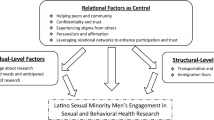Abstract
The use of indigenous researchers has long been practiced in ethnographic research; a similar use of indigenous personnel has not been as commonly undertaken in interview studies of men who have sex with men (MSM). This research note reports on the use of indigenous interviewers in a study of Latino MSM’s perceptions about sexual relationships and behaviors.
The full study explores sexual relationships among Latino MSM, and HIV risk behaviors undertaken by a population of MSM residing in a community in southern California. This research note describes both the strengths and limitations that arise from employing indigenous interviewers for improving the overall quality of sensitive data. Benefits discussed include improved access to an otherwise highly restricted group, enhanced rapport-building capabilities, and greater understanding of language unique to the study population. Limitations discussed include the use of previously untrained interview personnel and age and gender issues.
Similar content being viewed by others
References
Baum, F. (1998). The new public health: An Australian perspective. Melbourne, Australia: Oxford University Press.
Berg, B. L. (2004). Qualitative research methods for the social sciences (5th ed.), Boston: Allyn and Bacon, Inc.
Berg, B. L., & Larson, C.. (1989). Inmates’ perceptions on determinate and indeterminate sentencing. Journal of Behavioral Science and the Law, 7(1), 127–137.
Carpio, F. F. (2001). Social, cultural, and epidemiological considerations in HIV disease management in U. S. Latino populations. Topics in HIV Medicine, 9(2), 34–36. Retrieved August 10, 2003, from http://hivinsite.ucsf.edu/InSite.jsp?doc=md-04-01-11
Catania, J. A., Gibson, D. R., Chitwood, D. D., & Coates, T. J. (1990). Methodological problems in AIDS behavioral research: Influences on measurement error and participation bias in studies of sexual behavior. Psychological Bulletin, 108, 339–362.
Centers for Disease Control and Prevention. (2002). HIV/AIDS Surveillance Report, 14. Department of Health and Human Services, Public Health Service, Atlanta, GA.
Darbes, L. A., Kennedy, G. E., Peersman, G., Zohrabyan, L., & Rutherford, G. W. (2002). Systematic review of HIV behavioral prevention research in Latinos. Retrieved August 10, 2003, from University of California, San Francisco AIDS Research Institute and the Cochrane Collaborative Review Group on HIV/AIDS, http://hivinsite.ucsf.edu/InSite.jsp?page=kb-07-04-11
Diaz, R. M. (1998). Latino gay men and HIV: Culture, sexuality and risk behavior. New York: Routledge.
Diaz, R. M. & Ayala, G. (2001). Social discrimination and health: The case of Latino gay men and HIV risk. New York: The Policy Institute of the National Gay and Lesbian Task Force.
Esterberg, K. (2002). Qualitative methods in social research. Boston: McGraw Hill.
Fitzgerald, J. D. & Cox S. M. (2002). Research methods and statistics in criminal justice. Belmont, CA: Wadsworth.
Gubrium, J. (1991). Recognizing and analyzing local cultures. In W.B. Shaffir & R. Stebbins (Eds.), Experiencing fieldwork: An inside view of qualitative research (pp. 132–142). Newbury Park, CA: Sage Publications.
Johnson, B. Goldstein, P.J., Prebble, E., Schmeidler, J., Lipton, D.S., & Spunt, B., et al. (1985). Taking care of business. Lexington, MA: Lexington Books.
Johnson, J. C. (1991). Selecting ethnographic informants. Newbury Park, CA: Sage Publications.
Lee, R. M. (1993). Doing research on sensitive topics. Newbury Park, CA: Sage Publications.
Poll, S. (1969). The Hasidic Community of Williamsbury. New York: The Free Press of Glencoe, Inc.
Prebble E. & Casey, J. J. (1969). Taking care of business: The heroine user’s life on the street. International Journal of Addiction, 4, 1–24.
Rubin, H. J., & Rubin, I. S. (1995). Qualitative interviewing: The art of hearing data. Thousand Oaks, CA: Sage Publications.
Spradley, J. (1997). The ethnographic interview. Belmont, CA: International Thompson Publishing.
Stone, G. P. (1962). Appearance and self. In A. Rose (Ed.), Human behavior and social process. Boston: Houghton Mifflin.
Taylor, S.J. & Bogdan, R. (1998). Introduction to qualitative research methods (3rd ed.), New York: John Wiley & Sons, Inc.
Tewksbury, R. (2001). Acting like and insider: Studying hidden environments as a potential participant. In J. Mitchell Miller & R. Tewksbury (Eds.), Extreme methods (pp. 4–12). Boston: Allyn and Bacon, Inc.
Tewksbury, R. (2002). Bathhouse intercourse: Structural and behavioral aspects of an erotic oasis. Deviant Behavior: An International Journal, 23, 75–112.
Ueno, K. & Adams, R. G. (2001). Perceptions of social support availability and coping behaviors among gay men with HIV. The Sociological Quarterly, 42(3), 303–324.
Valleroy, L., Secura, G., Mackellar D., Behel S., & the Young Men’s Survey Study Group, (2001, February). High HIV and risk behavior prevalence among 23- to 29-year-old men who have sex with men in 6 US cities. Poster session presented at the 8th Conference on Retroviruses and Opportunistic Infections, Chicago.
Wolitski, R. J., Halkitis, P. N., Parsons, J. T., & Gomez, C. A. (2001). Awareness and use of untested barrier methods by HIV-Seropositive gay and bisexual men. AIDS Education and Prevention, 13(4), 291–301.
Author information
Authors and Affiliations
Rights and permissions
About this article
Cite this article
Berg, B.L., Sañudo, F., Hovell, M. et al. The use of indigenous interviewers in a study of latino men who have sex with men: A research note. Sex Cult 8, 87–103 (2004). https://doi.org/10.1007/s12119-004-1007-0
Issue Date:
DOI: https://doi.org/10.1007/s12119-004-1007-0




